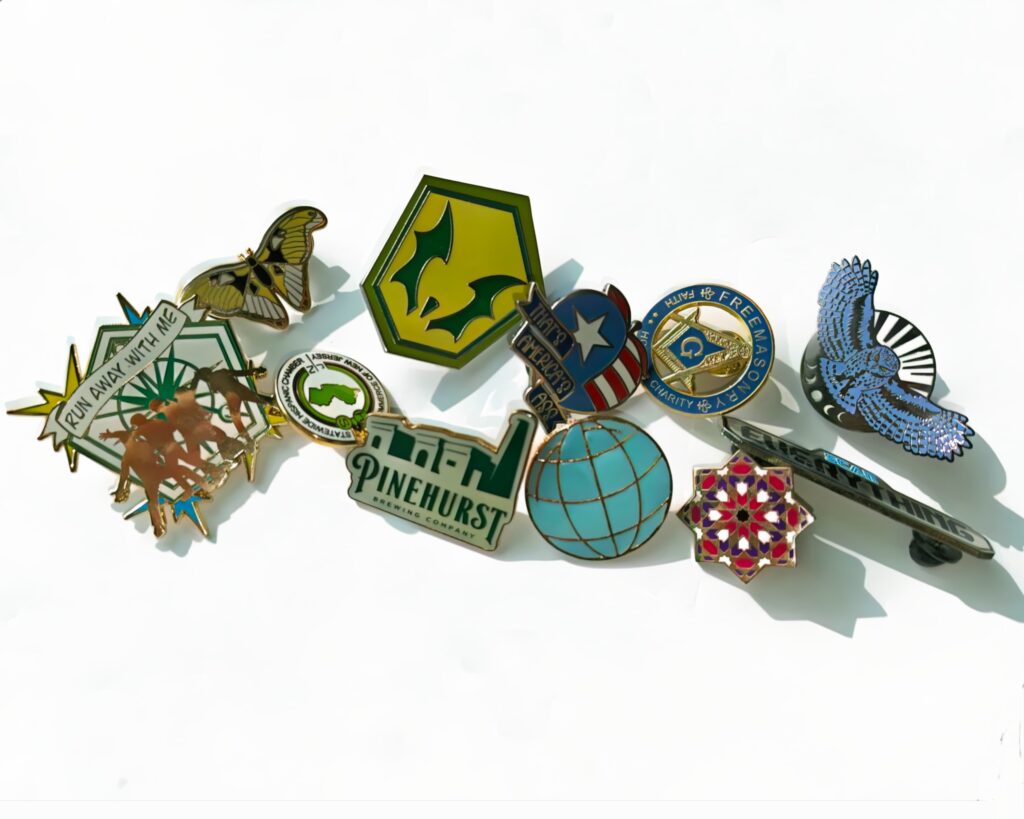Hard enamel pins and soft enamel pins are popular items used in promotional campaigns, fashion statements, and more. But what is the difference between the two enamel pins?
When it comes to creating new pins, it can be difficult to decide between hard and soft enamel. Both have their benefits and drawbacks that need to be taken into consideration.
This article aims to simplify the selection process of enamel pins by outlining the differences between hard enamel pins and soft enamel pins. With this information, it should be easier for you to make your decision.
Hard vs soft enamel pins – What is the difference
Simple answer:
Texture. Hard enamel features a smooth surface whereas soft enamel has a textured finish with metal die lines.
Top answer:
Soft enamel pins have a raised edge, while hard enamel pins typically do not. With hard enamel, everything is glossy, smooth, and flush.
Generally, soft enamel pins are comparatively less refined, more cost-efficient, and can include a larger range of colors and designs.
On the other hand, hard enamel is more durable, scratch-resistant, and has a superior finished appearance.
To make your decision easier, here’s a quick comparison of hard and soft enamel pins:
| Feature | Hard Enamel | Soft Enamel |
|---|---|---|
| Finish | Smooth, flat, glossy | Textured, raised metal details |
| Durability | Highly durable, scratch-resistant | Durable but slightly less so |
| Price | Higher cost due to polishing | More budget-friendly |
| Colors | Limited but elegant | Bright and vibrant |
| Best For | Corporate, professional designs | Artistic, intricate, colorful designs |
What are Hard Enamel Pins
Hard enamel features a glossy surface. No dips or irregularities.
After the filling has been completed, it is then buffed and polished until it has a perfectly smooth finish.

Hard Enamel Pins Manufacturing Process
Hard vs soft enamel pins – When to Pick Hard Enamel
Hard enamel pins are more robust and less prone to damage, as the manufacturing of them requires a higher temperature than the production of soft enamel pins and then is further refined with polishing.
Whether to go for soft or hard enamel often boils down to individual preference. Hard enamel can be beneficial in certain cases, especially if you’re looking to plate gold or silver.
Hard enamel badges have excellent durability, making them an ideal choice for businesses and organizations wanting to convey a high-quality, polished look. These badges are often seen in fancier settings due to their superior appearance.
Hard vs soft enamel pins – Hard Enamel Pin Construction
Crafting a hard enamel pin requires a unique combination of steps that should be followed in a specific order for the desired result.
Crafting a hard enamel pin is a complex process that requires a specific set of steps to be followed in order to ensure the desired result. From designing the artwork, to preparing the metal surface, to filling in with enamel paint and finally baking it; each step needs to be carefully completed in order for it to look professional. With proper care and attention, you can create stunning hard enamel pins with ease.
What are Soft Enamel Pins
Soft enamel pins are made with a softer epoxy coating that is also baked at a high temperature but has an uneven finish. Both types of pins can feature intricate designs and come in various sizes and shapes. The main difference between them is the type of finish they have; hard enamel pins have a glossy look while soft enamel pins have an uneven look.
Soft enamel badges are created by filling the mold with enamel and baking at a comparatively low temperature. All the enamel is added in one go, which causes it to dry simultaneously.
When you run your finger over the surface of a soft enamel badge, it will cause a smooth, raised sensation due to the texture of the material.
The enamel used for creating badges is dried underneath the metal ridges in the mold, which separates the colors and prevents them from mixing together. This produces a layered or “dimensional” effect on your badge.
Soft enamel badges are not flat and smooth like other pins. You can feel the ridges and valleys formed by the design when you run your fingers over them.

Soft Enamel Pins Manufacturing Process
Hard vs soft enamel pins – When to Pick Soft Enamel
Soft enamel is the only way to achieve unique, customized badge finishes like rainbow plated, painted black, or just about any other color. Soft enamel is less scratch resistant.
Soft enamel badges are the ideal choice as they offer a high degree of durability and can be purchased in bulk at a great price point. They are also quite popular and often the first thing that comes to mind when talking about enamel badges.
Hard vs soft enamel pins – Soft enamel pin construction
To finish a soft enamel pin, the plating must be done first and then there are three simple steps to complete it.
Soft enamel pins are a popular way to show off your style and express yourself. They are easy to customize and can be used for a variety of purposes, from promotional items to collectible memorabilia. To finish a soft enamel pin, the plating must be done first and then there are three simple steps to complete it: filling the recessed areas with enamel paint, polishing the surface of the pin, and adding a protective coating. With these steps, you can create a beautiful piece of jewelry that will last for years.
FAQs
1.What is a soft enamel lapel pin?
Soft enamel lapel pins are a popular way to show off a company logo or special event. They are made from metal, typically copper or iron, and then filled with colored enamel paint. The raised areas of the pin are polished to create an eye-catching finish that is sure to draw attention.
Soft enamel lapel pins offer a great way to add style and flair to any outfit, whether it be for business or pleasure. With their vibrant colors and unique designs, they can be used as a great way to show off your individual style or promote your business or organization.
2.Why are enamel pins so expensive?
Enamel pins have become a popular fashion accessory in recent years, but why are they so expensive?
Prices for enamel pins can range from a few dollars to hundreds of dollars, depending on the design and materials used.
To understand why enamel pins are so expensive, it’s important to look at the production process.
Enamel pins require multiple steps to create, including die-casting, coloring, and polishing. The cost of materials can also add up quickly when creating custom designs with high-quality metals and enamels.
Additionally, many pin makers only produce limited runs of each design which contributes to the cost of each pin. All these factors make enamel pins a unique and costly fashion statement.
References
Soft Enamel VS Hard Enamel Pins, What is the Difference?
Soft Enamel vs. Hard Enamel – Which Should You Choose?
Hard vs Soft Enamel Pins – The Real Differences
Soft Enamel vs Hard Enamel Pins – The Differences
Read More
- Create Custom Lapel Pins with Our Lapel Pin Maker
- Best Custom Pins Online: Quality Design & Fast Delivery
- The Ultimate Guide to Custom Metal Badges (2025): How to Create Standout Designs with China’s Top Manufacturer
- How to Wear Pins? Find the Perfect Style and Placement for You
- 5 Must-Consider Elements for Designing Stunning Custom Coins



